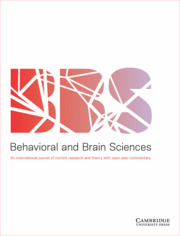Article contents
Representation is representation of similarities
Published online by Cambridge University Press: 01 August 1998
Abstract
Advanced perceptual systems are faced with the problem of securing a principled (ideally, veridical) relationship between the world and its internal representation. I propose a unified approach to visual representation, addressing the need for superordinate and basic-level categorization and for the identification of specific instances of familiar categories. According to the proposed theory, a shape is represented internally by the responses of a small number of tuned modules, each broadly selective for some reference shape, whose similarity to the stimulus it measures. This amounts to embedding the stimulus in a low-dimensional proximal shape space spanned by the outputs of the active modules. This shape space supports representations of distal shape similarities that are veridical as Shepard's (1968) second-order isomorphisms (i.e., correspondence between distal and proximal similarities among shapes, rather than between distal shapes and their proximal representations). Representation in terms of similarities to reference shapes supports processing (e.g., discrimination) of shapes that are radically different from the reference ones, without the need for the computationally problematic decomposition into parts required by other theories. Furthermore, a general expression for similarity between two stimuli, based on comparisons to reference shapes, can be used to derive models of perceived similarity ranging from continuous, symmetric, and hierarchical ones, as in multidimensional scaling (Shepard 1980), to discrete and nonhierarchical ones, as in the general contrast models (Shepard & Arabie 1979; Tversky 1977).
Keywords
Information
- Type
- Research Article
- Information
- Copyright
- © 1998 Cambridge University Press
- 218
- Cited by

